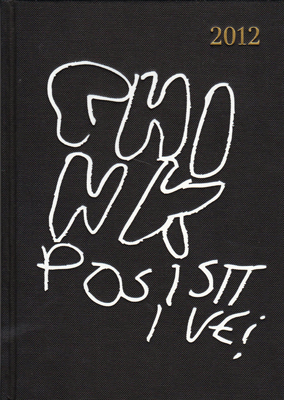John Hurrell – 3 October, 2013
Arps' book has a nice feel of decipherable chaos. Its material is abandoned in mood but that is just first glance. It doesn't take too long to realise that is actually expertly layered and curiously logical. It is a different sort of book than the more overtly random 'Affirmative Dungeon': it's very self contained and strangely tight. The way it draws you in to dip into the texts also sheds light on Moore's practice, such as his current show on at Artspace.
Dan Arps
The Downward Spiral
Limited edition artist’s book
Text by Dan Arps and Tahi Moore
Drawings and images by Dan Arps
Designed by Kelvin Soh and Sam Wieck
Hardcover, 192 pp
This unusual artist’s book by Dan Arps is structured around a 2012 continuously lined diary into which other forms of printed image have been shrewdly overlaid, either on its hard black cover or white noncalendar pages within. With a title like The Downward Spiral and a cover drawing of ‘Think Positive’ it seems to be about an individual’s or nation’s slide into poverty, although it also could be about personal depression. And like his other major hardcover publication, Affirmation Dungeon, it is carefully structured with its precisely positioned visual ingredients and texts, except here, texts and visual ingredients are emphatically the same thing.
The Downward Spiral is a visual book which you first look at carefully in order to figure out how to read the presented pages. The same sprawling text by Arps and Tahi Moore is repeated twice, once in the middle in a hand printed scrawl (40 pages of continuous writing with no spacing), and again at the end in typed, paragraphed copy (25 pages) where fine marker pen, black ink drawings and scribbled text have been shrewdly superimposed to resonate with the typed content. Other short texts in caps, like ‘Diagnosing the State ‘, ‘Caught between the Hammer and the Eternal Anvil’, ‘Bad Planning,’ Natural Balance’ and ‘Think Negative’, are regularly positioned on the lined pages that regularly dominate the rest of the book. If inclined you can pick out the same written/typed sections of ‘Dialogue/diatribe’ with Tahi Moore and see if different accentuations - nuances of meaning - occur with different punctuation.
Interspersed with such phrases as Become the State /I am the State / Become Thru /Becoming Worse / Embrace the Sludge, are images of adolescents posing in illustrations for first aid procedures, ‘nurses’ putting ‘victims’ into recovery positions. These are occasionally mixed with reproductions of Arps collages or found artworks, drawings of Snakes and Ladders, the occasional Ouroboros (hooped snake with its tail in its mouth), and later, Synthetic Rebirthing Workshops and pages from Anarchist chat rooms.
In a self reflexive process the purpose of these handwritten phrases becomes apparent in Arps and Moore’s text (my hunch is it is mainly Moore) that running beneath them:
Planning around ideas of things. Planning around ideas of words. Using words for things, shifting those words to different kinds of things. Deep sea diving into an objective structural assemblage of language, but not quite that. Can language be subjective - I’ll re-read old writing and it’ll be different every time, but with short statements that get attached to ideas and feelings, as in notions like a phrase use in a default line for an event which itself is never analysed (the phrase, not the event), the phrase remains the same. Short phrase notions act as structures themselves, like black boxes, you don’t need to look into them, you just use them. Moving ideas about people. Conformal recognition. More like choosing between different discourses and language structures. Making decisions based on the feel of a phrase. (p. 59; p.176)
The book has a nice feel of decipherable chaos. Its material is abandoned in mood but that is just first glance. It doesn’t take too long to realise that it is actually expertly layered and curiously logical. It is a different sort of book than the more overtly random Affirmative Dungeon: it’s very self contained and strangely tight. The way it draws you in to dip into the texts also sheds light on Moore’s practice, such as his current show on at Artspace. (The sections on driving seem particularly apt.)
Arps and Moore’s text, Arps’ own drawings and phrases, when all blended with DDMMYY’s formidable design make a fascinating combination. A significantly innovative publication.
John Hurrell

 Two Rooms presents a program of residencies and projects
Two Rooms presents a program of residencies and projects Advertising in this column
Advertising in this column



This Discussion has 0 comments.
Comment
Participate
Register to Participate.
Sign in
Sign in to an existing account.